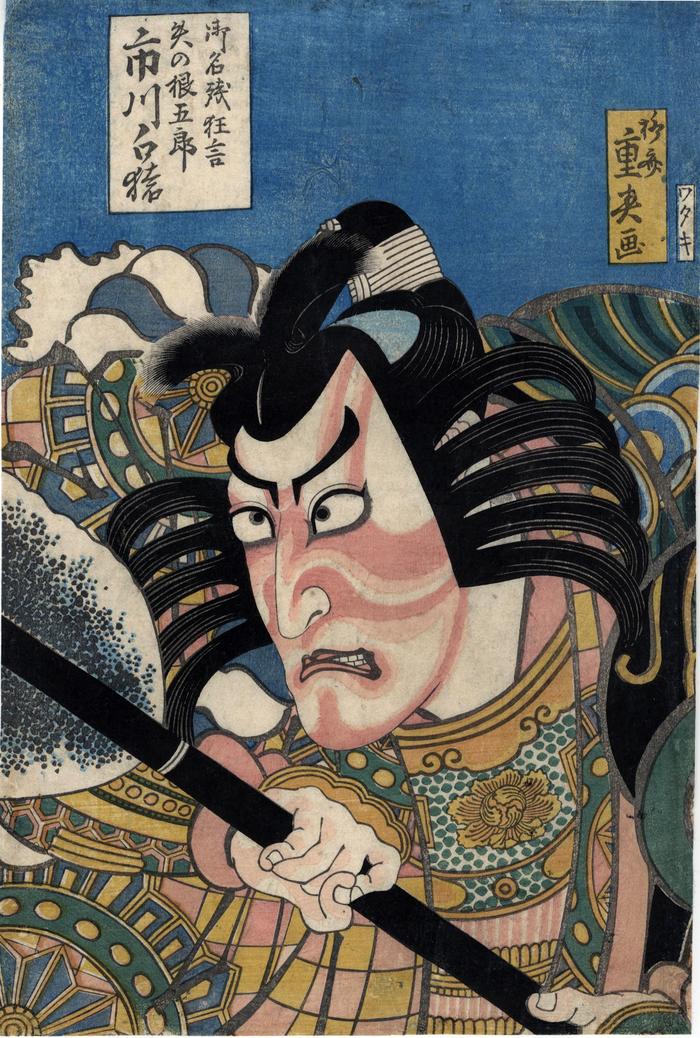Ryūsai Shigeharu (柳斎重春) (artist 1802 – 1852)
Ichikawa Hakuen II (市川白猿) as Yanone Gorō (矢の根五郎) sharpening his giant arrow in the play Oniwaka Nagori no Motodori (鬼若名残髻 - 'Oniwaka's farewell topknot')
09/1829
10 in x 14.75 in (Overall dimensions) Japanese color woodblock print
Signed: Ryūsai Shigeharu
柳斎重春画
Publisher: Wataya Kihei (Marks 579 - seal 25-056)
Waseda University Osakaprints.com wrote: "Oniwaka nagori no motodori (Oniwaka's farewell topknot: 鬼若名残髻) is the title given to a group of five hayagawari (quick-change: 早替り) dances for which Hakuen performed five different male roles. These were part of a program of onagori kyōgen (farewell plays: (御名残狂言) that commemorated Hakuen's imminent departure for the provinces and ultimate return to Edo. Typically, onagori kyōgen included selections of an actor's most admired or favorite roles."
They added later: "Monokawa Kurando is one of five dance-roles performed by Hakuen; others in the grouping include Oniwakamaru (鬼若丸), Atakaseki Benkei (あたか関べんけい), and an ice-water vendor (Reisui uri: 冷水うり). These four full-length figures are complemented by an impressive ōkubi-e ("large-head" or bust portrait: 大首絵) design with Hakuen in the role of Yanone Gorō (矢の根五郎)."
****
The peony in the center of the actor's breastplate is a crest used by Danjūrō VII, aka Hakuen II.
****
"This is one of the most expressive Ōsaka bust-portraits. The face with beniguma make-up, shown in a mie or fixed pose, is in the centre of the print, with the line of the shoulders as high as Hakuen's hairknot. This excites the idea that the actor bends to the front. The multi-coloured pattern on the clothes, in combination with the make-up and the complicated coiffure (a kuruma-bin wig) create a poignant effect against the plain background at top. In strong terms they portray the atmosphere of the aragoto-style of acting. The scene is one from a performance in which Hakuen played five different roles, related to five different plays. These roles have been interpreted in a dance and the one represented here is from the famous play 'Yanone', in which one of the highlights is the sharpening of arrowheads. It concerned a farewell performance on the occasions of Hakuen's announced return to Edo. The actor used the name Hakuen temporarily in 1829 and 1830. He is better known as Ichikawa Danjūrō VII."
Quoted from: Ōsaka Kagami 大阪鏡 by Jan van Doesburg, p. 70. This is accompanied by a full-page black and white illustration on page 71.
****
Illustrated in:
1) a full page color reproduction in Osaka Prints by Dean J. Schwaab, Rizzoli, 1989, page 141, no. 133. This print commemorates a performance at the Naka Theater in the 9th month of 1829. Schwaab wrote:
"This bust portrait is probably the most memorable image of the actor from this first visit, and perhaps from all of his Ōsaka performances. The print illustrates one of five roles performed as a grand finale dance to a larger performance. The print's actual role description gives "Yanone Gorō," but this is to indicate that it is the part of Soga Gorō excerpted from the play Yanone. The cartouche also indicates that this is a farewell performance, a decision the actor seems to have made on the 23rd day of the month; and indeed Hakuen left on a short tour of the outlying districts and Kyōto in the tenth month, returning to Ōsaka at the beginning of 1830."
2) a full page color reproduction Schätze der Kamigata: Japanische Farbholzschnitte aus Osaka 1780-1880, MNHA (Musée national d'histoire et d'art Luxembourg), 2012, p. 40, #57. The catalog entry reads:
"Oniwaka Nagori no Motodori" ist ein Tanzstück, in dem Ichikawa Ebizo V., der zu besondern Anlässen unter dem Ehrennamen Hakuen auftrat, Tanzszenen aus verscheidenen Stücken spielte, darunter aus dem Stück "Ya no Ne" (Die Pfeilspitze), das zu den "Juhachiban", dem 18 Stücke Zyklus der Danjuro Familie gehörte, deren bedeutendster Vertreter um 1830 Ichikawa Danjuro VII. = Ebizo V. war.
Schminke und Frisur geben bildhaft den bombastichen Stil (Aragoto) wieder, in dem das Stück, Ya no Ne" [sic] aufgeführt wurde.
The Google translation is:
"Oniwaka Nagori no Motodori" is a dance piece in which Ichikawa Ebizo V, who performed under the honorary name of Hakuen on special occasions, performed dance scenes from various pieces, including "Ya no Ne" (The Arrowhead), which was one of the "Juhachiban" belonged to the 18-piece cycle of the Danjuro family, whose most important representative around 1830 was Ichikawa Danjuro VII. = Ebizo V.
The make-up and hairstyle vividly reproduce the bombastic style (aragoto) in which the play, Ya no Ne" [sic] was performed."
3) in a full-page black and white reproduction in Osaka Kagami by Jan van Doesburg, Huys den Esch, 1985, page 71, no. 60.
Wataya Kihei (綿屋喜兵衛) (publisher)
Kyōto-Osaka prints (kamigata-e - 上方絵) (genre)
actor prints (yakusha-e - 役者絵) (genre)
Ichikawa Hakuen II (二代目市川白猿) (actor)
Soga brothers (曾我兄弟) (genre)
